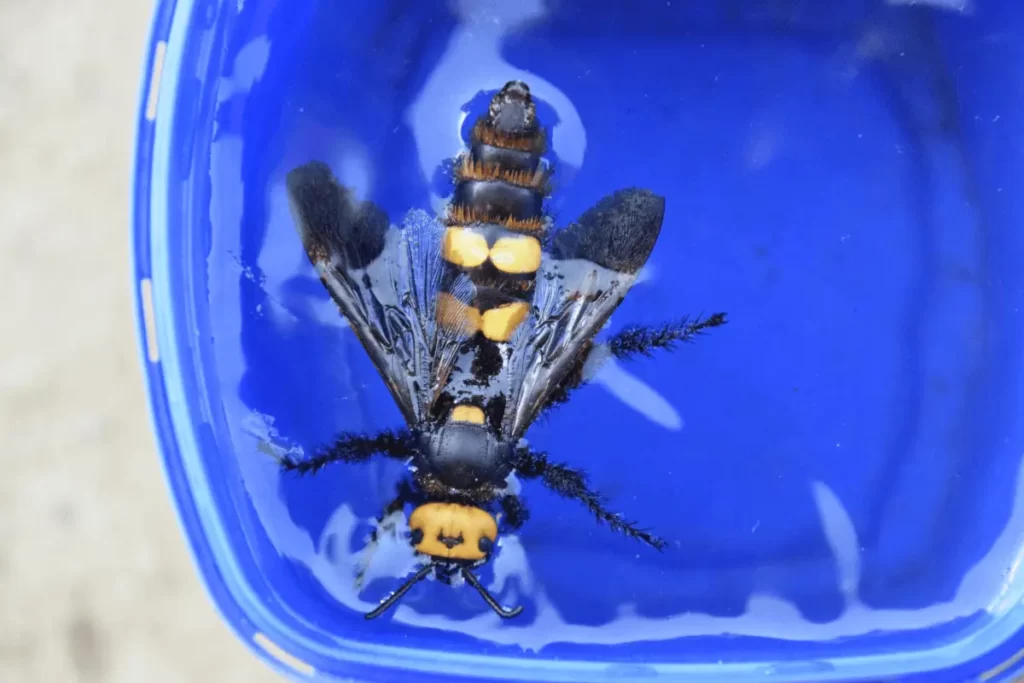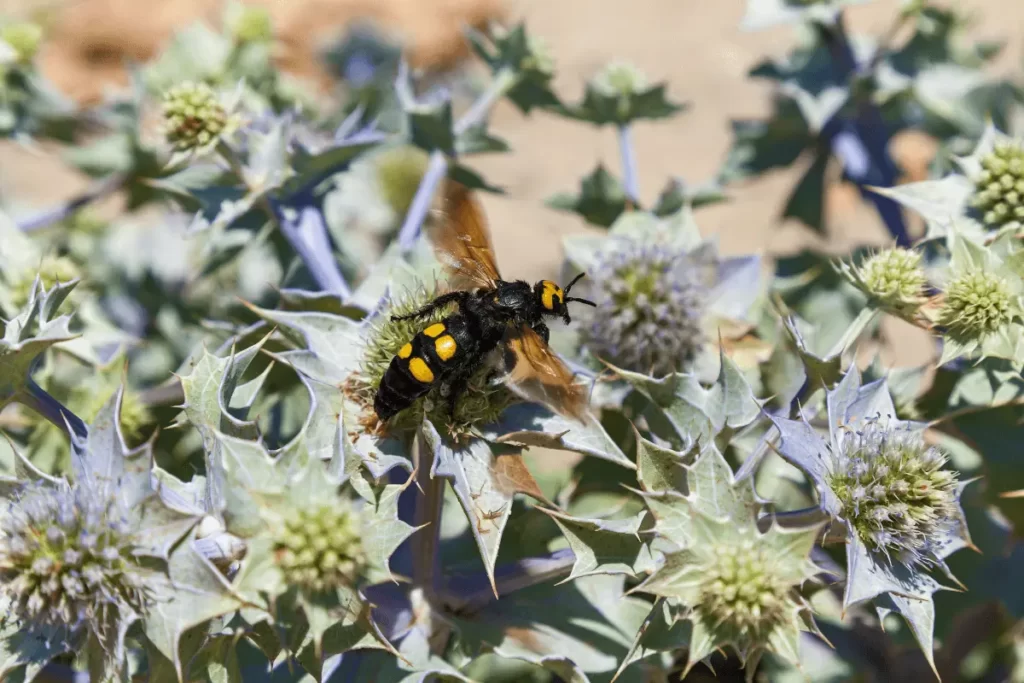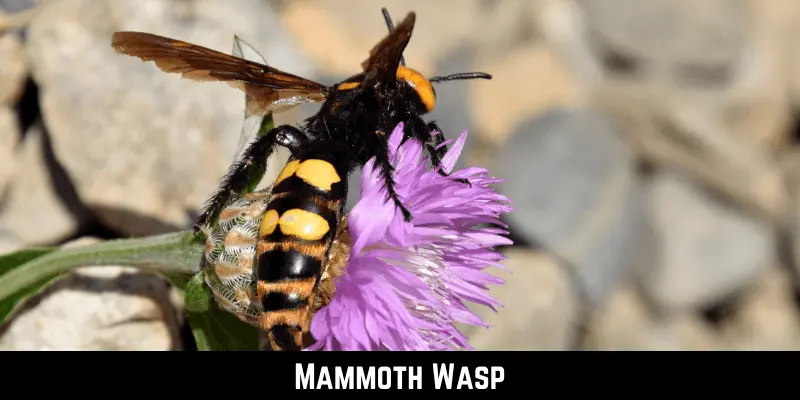The first thought that comes to mind after imagining a wasp is probably the tiny, black, and yellow insects that buzz around your picnic table. However, you may see a massive wasp wandering in your yard. Do you know; that might be a mammoth wasp? So, what are they?
Mammoth wasps are also known as Megascolia maculate and are present throughout Europe. They have yellow heads with bristle hair and black body. You can see them during warm weather conditions. Additionally, these wasp species are not social. They tend to live alone and are rarely observed in groups.
Are you interested in knowing everything about the mammoth wasps? If so, read the below guidelines to upgrade your knowledge.
What Are Mammoth Wasps?
Mammoth wasps are members of the order Hymenoptera’s Scoliidae family. It is a solitary parasitoid of scarab beetles and loves to live alone. Below are some details of these wasps:
Appearance of Mammoth Wasp

The mammoth wasp looks like an enormous, elongated bumble bee. The male mammoth wasp has a black head and is smaller than the yellow-headed female. There are two yellow bands across its abdomen, which separate into four yellow spots, and it has glossy black, downy hair covering its body.
Moreover, compared to males, females have shorter antennae. The females are larger than the males and can grow to a length of 4.5 cm (1.8 in). The warmer months of late May, June, July, and August are when these wasps are most likely to be seen as they hover around flowers in search of nectar.
Distribution of Mammoth Wasp
The mammoth wasp was discovered in 2013 in the Czech Republic. This enormous wasp lives in southern Europe up into Russia, North Africa, and the Near East. It has been spotted in Southern Great Britain, but since its prey is not present there, it cannot establish itself there.
Additionally, Hungary is home to the Mammoth Wasp, which prefers dry, warm environments. It frequently lives on rotting logs because there are still remnants of chopped trees in the ground where their host species can grow.
The Behavior of Mammoth Wasp
Mammoth wasp adults consume floral nectar. In Malta, they have been linked to “Carpobrotus edulis” and wild artichokes. The female mammoth wasp searches for the European rhinoceros beetle’s grubs, which she paralyzes with a sting before laying a single egg on the larva. After that, the wasp’s larvae consume the paralyzed beetle larva as a source of food as they grow and develop and then emerge as an adult the following spring.
Habitat of Mammoth Wasp
Megascolia maculate or mammoth wasps mainly inhabit open environments like grasslands, meadows, gardens, and agricultural areas. They are often seen near flowering plants, as they feed on nectar and are important pollinators for various flowering species. Their unique coloration serves as a warning to potential predators, and they are known for their parasitic reproductive behavior involving other insect larvae.
How Do You Recognize a Mammoth Wasp?
The mammoth wasp is a huge and remarkable insect present across Asia. It is also known as a gigantic scoliid wasp and spotted giant scoliid. Besides that, it’s well renowned for its size and remarkable beauty. Here are some ways by which you can recognize a mammoth wasp.
- The mammoth wasp is a giant wasp, with females being larger than males. Females can reach lengths of about 3-4 inches, while males are slightly smaller.
- Its color is what sets it apart from other species. It has a black body with vivid yellow or orange patterns.
- Further, this wasp has a solid, cylindrical body. It has a large, rounded abdomen and a thick waist. The head is relatively small compared to the body.
- The wings of Mammoth wasps are transparent and membranous, with dark veins running through them.
- Additionally, their eyes are large and often have a reddish or brownish tint. The antennae are relatively short and have several segments.
What Do Mammoth Wasps Eat?

Adult Mammoth wasps primarily feed on nectar from flowers. They are important pollinators as they visit flowers to feed on nectar and inadvertently transfer pollen from one flower to another, aiding in the reproductive process of plants.
However, their larvae have a unique and somewhat gruesome feeding behavior. Female Mammoth wasps locate the larvae of rhinoceros beetles (specifically, the coconut rhinoceros beetle) in decaying wood or underground tunnels. They lay their eggs on or near these beetle larvae. When the wasp eggs hatch, the wasp larvae start to feed on the beetle larvae, using them as a source of nutrition.
This parasitic behavior helps control the population of rhinoceros beetles, which can be agricultural pests. In conclusion, an adult Mammoth wasp mostly consumes floral nectar, whilst their larvae parasitize rhinoceros beetle larvae and eat their young.
Where Does a Mammoth Wasp Live?
Mammoth wasps, also referred to as the “giant flower wasps” or “spotted giant scoliid wasps,” are the type of solitary wasps that can be found throughout Asia. These wasps are distinguished by their striking color and big size. They frequently inhabit forests, gardens, and agricultural regions in tropical and subtropical settings.
While these wasps can be found in different parts of Asia, such as India, China, and Southeast Asian countries, their specific distribution can vary within these regions. These wasps typically inhabit areas with suitable nesting sites, such as sandy or loose soil where they can dig their burrows to lay eggs. They are also known for their role in pollination as they visit flowers in search of nectar.
Furthermore, these wasps are often associated with areas that have sandy or loose soil, as they nest in the ground. Female wasps dig burrows in the dirt where they lay their eggs, usually near the larvae of beetles or other insects. After hatching, they consume the host insect before pupating, eventually emerging as adult wasps.
What Is the Life Cycle of a Mammoth Wasp?
The life cycle of mammoth wasps consists of four stages that are given below:
- Egg Stage: The life cycle of Megascolia maculata begins when a female wasp lays eggs. The female typically searches for suitable tree trunks or logs where she can lay her eggs. She selects a location with existing beetle larvae or other wood-boring insect larvae, which will serve as a food source for her developing offspring.
- Larval Stage: Once the eggs hatch, the larval stage begins. The developing larva feeds on the wood-boring insect larvae present in the chosen location. The female wasp may provision the nest with paralyzed insects or spiders as food for her offspring. The larva goes through several instars (growth stages) as it continues to feed and develop within the protective environment of the nest.
- Pupal Stage: After completing its growth and development, the larva pupates. During this stage, the larva transforms into an adult wasp inside a cocoon-like structure. The pupal stage is a critical period of metamorphosis, during which the internal structures of the larva reorganize to form the adult body.
- Adult Stage: Once the transformation is complete, the adult Megascolia maculata wasp emerges from the cocoon. The adult wasp is sexually mature and ready to reproduce. Female wasps of this species tend to be larger than males. Adult wasps are typically solitary and do not form colonies. They are famous for their impressive size, distinctive coloration, and long ovipositor.
- Reproduction: The adult female wasp’s primary goal is to find suitable nesting sites for her offspring. She will search for trees or logs that have wood-boring insect larvae present. Once she locates the most suitable site, she lays her eggs near or on the larvae of the wood-boring insects. The developing wasp larvae will use these larvae as a food source.
Life Span of a Mammoth Wasp
A Mammoth wasp’s lifespan can change based on things including the environment, food supply, and predator activity. However, generally speaking, the adult lifespan of these wasps is relatively short, typically ranging from a few weeks to a couple of months. It is a common pattern among many solitary wasp species, as their primary focus is on reproduction rather than long-term survival.
Additionally, throughout the winter, they remain in the pupal stage before emerging in the spring. Adult wasps do not live for long. They frequently pass away before the season begins because they can’t withstand the winter. Their primary purpose is to mate, forage for food, and lay eggs. The eggs they lay will develop into the next generation of wasps.
Does a Mammoth Wasp Bite?
Yes, mammoth wasps are solitary wasps and can bite humans. While they primarily feed on flower nectar, these stinging insects don’t attack you and will only do so if they feel threatened. However, its primary defense mechanism is not biting but rather its ability to sting.
The female wasp has a stinger at the end of her abdomen, which she can use for defense and to paralyze her prey. The sting can be painful, and in some cases, people might experience localized swelling, redness, and discomfort at the site of the sting.
It’s crucial to use caution and avoid teasing these wasps in their natural environment to reduce the possibility of being stung. Above all, it’s advised to keep your distance when you come across one and avoid any sudden movements that can startle the wasp.
Are Mammoth Wasps Poisonous?
No, mammoth wasps aren’t poisonous but can bite you if you tease them. They are kind of sizable solitary wasp that feeds on cicadas, employing them to stock their nests with food for their growing larvae.
The venom of Mammoth wasps is not highly toxic to humans, and most of the time you only experience localized pain, redness, and swelling at the sting site. However, individual reactions to insect stings can vary, and in some cases, you may experience more severe allergic reactions.
It’s critical to seek medical help immediately if a giant wasp stings you and you have symptoms of a severe allergic reaction, including trouble breathing, throat swelling, or widespread hives. Furthermore, as with other potentially stinging or biting insects, it’s best to keep a safe distance from these wasps to reduce the chance of being stung.
Mammoth Wasps; Harmful or Beneficial?
Mammoth wasps are typically regarded as beneficial insects, regardless of whether they are harmful or not. They are primarily nectar feeders and are important pollinators for several flowering plants. Their feeding behaviors support plant pollination, which improves ecosystem health and biodiversity.
They are not hostile to people and don’t form colonies because they are solitary wasps. Mostly, they won’t sting unless provoked or handled, and even then, their stings aren’t any more lethal than those of other common wasp species.
However, like many insects, these wasps have their role in the ecosystem, and their interactions with other organisms can be complex. For example, their larvae develop as parasitoids of beetle grubs that inhabit decaying wood. The female wasp lays her eggs on or near the beetle larvae, and when the wasp larvae hatch, they feed on the beetle grub, eventually killing it.
Even though this activity might not seem advantageous to the beetle, it helps the environment’s food cycle.
How to Dispose of Mammoth Wasps?
Here are some actions to think about if you have a nest of Mammoth wasps and wish to deal with the problem:
- Find the Location of Nest: Find their nest. These wasps frequently build their nests underground, and such nests may resemble tiny burrows or holes.
- Observe Their Behavior: If the wasps are not harming or directly endangering you, you might leave them alone. They assist in pollination and are often non-aggressive unless they perceive a threat.
- Employ a Barrier: If their nest passes by your way, you can create a barrier around the nest using cones, flags, or other markers. It will help you and others avoid accidentally disturbing the nest.
- Don’t Disturb Them: If you decide to remove the nest, it’s vital to do so carefully and without causing harm to the wasps. Wear protective clothing and work when the wasps are less active, such as early morning or late evening.
- Ask for Help from Professionals: If the wasps’ presence poses a direct threat to you, your family, or your pets, it’s advisable to seek help from a professional pest control service or a local entomologist. They can evaluate the problem and make recommendations for the best course of action.
- Relocate the Nests: If the nest contains pupae or larvae, you can release them in a suitable outdoor area away from human activity. Remember that these wasps play a role in ecosystems as pollinators, so relocating them rather than exterminating them is a more eco-friendly option.
Apart from that, it’s crucial to treat all species, including insects, with respect and consideration for their ecological importance.
Some Other Facts About Mammoth Wasp
Mammoth wasps have impressive size, striking coloration, and interesting behavior. Here are some other interesting facts about these wasps:
- The mammoth wasp is one of the largest wasps in the world, with females reaching lengths of up to 4-5 cm (1.6-2 inches) and males being slightly smaller. This considerable size contributes to their intimidating appearance.
- These wasps have distinctive and attractive coloration. They typically have a black body with bright yellow markings on their abdomen. The combination of black and yellow makes them visually striking.
- In the mature stage, male wasps emerge before females. Male wasps may fly up to 19-59 inches in search of their female partners.
- Another interesting fact about these insects is that the remains of their host keep close to the cocoon when the larvae construct one around themselves.
- Above all, mammoth wasp contributes to the ecosystem by aiding in pollination and controlling populations of scarab beetles, which are often considered agricultural pests due to their feeding habits on plant roots.
Other Wasps In The USA
If you are interested in knowing other species of wasps found in the USA, You can find everything about these species here:
Final Verdict
Mammoth Wasp is a visually impressive insect with distinctive coloration. They are common in Southern Europe and parts of Hungary. Additionally, you may locate them across different parts of North America. It plays a significant role in natural pest control by preying on beetle larvae.
Despite its intimidating appearance, it generally doesn’t pose a threat to humans and can even contribute to pollination efforts. Eliminate rotting logs and flowering plants like lavender, silk plants, and others from around your home to deter these wasps.
Lastly, keep in mind that they can give nasty stings, so be careful around them.

